OCZ Vertex 4 Review (128GB), Firmware 1.4/1.5 Tested
by Kristian Vättö on August 4, 2012 10:00 AM ESTRandom Read/Write Speed
The four corners of SSD performance are as follows: random read, random write, sequential read and sequential write speed. Random accesses are generally small in size, while sequential accesses tend to be larger and thus we have the four Iometer tests we use in all of our reviews. Our first test writes 4KB in a completely random pattern over an 8GB space of the drive to simulate the sort of random access that you'd see on an OS drive (even this is more stressful than a normal desktop user would see).
We perform three concurrent IOs and run the test for 3 minutes. The results reported are in average MB/s over the entire time. We use both standard pseudo randomly generated data for each write as well as fully random data to show you both the maximum and minimum performance offered by SandForce based drives in these tests. The average performance of SF drives will likely be somewhere in between the two values for each drive you see in the graphs. For an understanding of why this matters, read our original SandForce article.
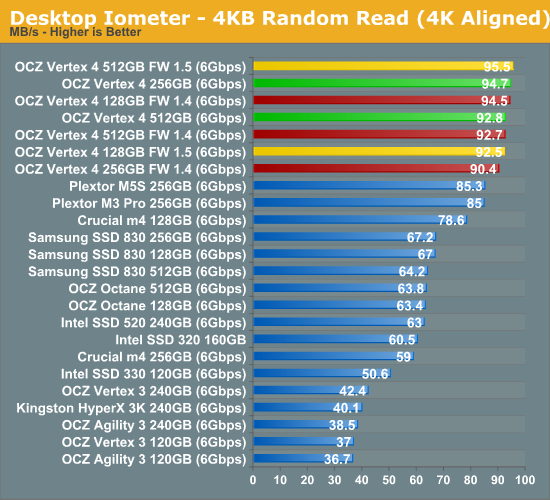
.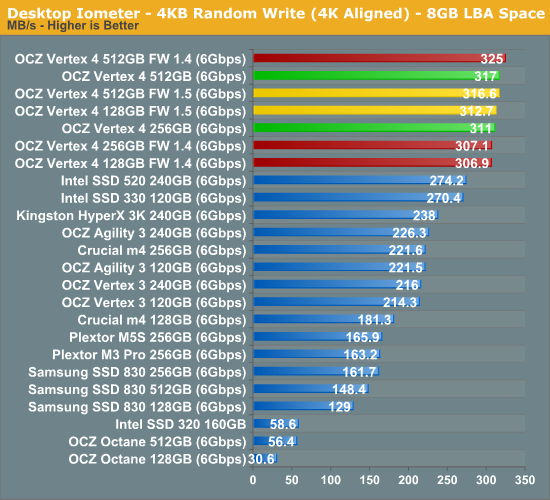
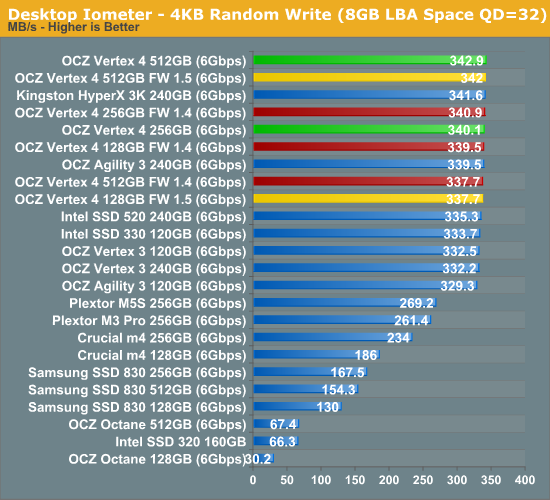
Neither the 1.4 or 1.5 firmware promised any improvements regarding random read/write performance.
As for the 128GB model, which is new in our tests, its random read/write performance is actually on-par with 256GB and 512GB capacities. This is a pleasant surprise the difference between the 128GB and 256GB capacities in many families can be quite substantial (e.g. Samsung's SSD 830).
Sequential Read/Write Speed
To measure sequential performance we ran a one minute long 128KB sequential test over the entire span of the drive at a queue depth of 1. The results reported are in average MB/s over the entire test length.
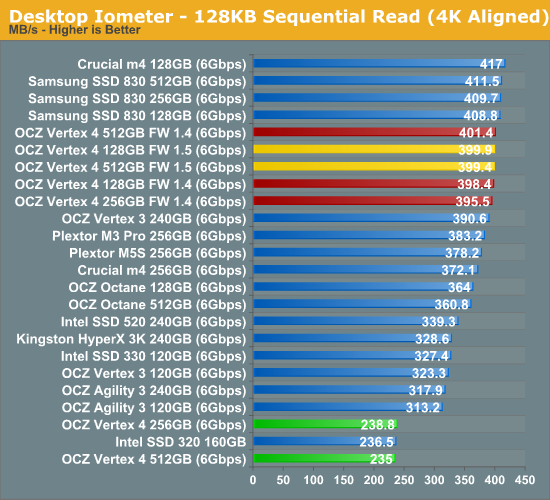
It's relieving to look at the graph above. It's now a fact that the 1.4 firmware fixes the sequential read speed at low queue depths issue. Not only does the firmware fix the issue, the sequential read performance is also very good.
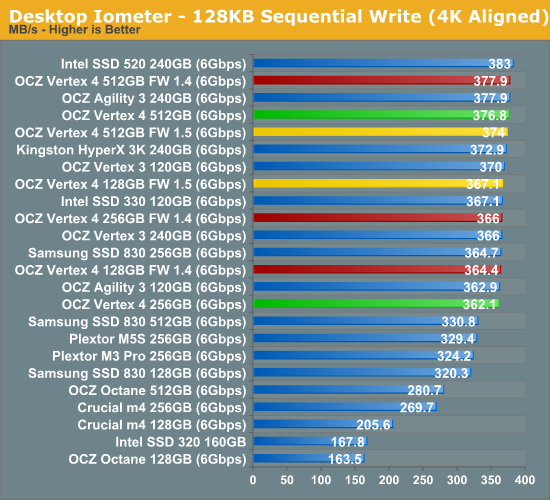
OCZ was promising increased sequential write performance for all models with the 1.5 firmware but at least in Iometer, at low queue depths, the difference is negligible. We'll take a look at AS-SSD and ATTO at higher queue depths next.










60 Comments
View All Comments
Flunk - Saturday, August 4, 2012 - link
It's not realistic to assume that users will really keep SSDs only 50% full, especially 128GB or 256GB drives. It seems like this feature is purely to benchmark better in reviews and that's low, even for hardware manufacturers. I'm sure that less well-informed reviewers will be tricked by this and publish misleading reviews.To clarify something, I'm not saying that this is a bad product, just that this feature is misleading. If I were set on buying an SSD from OCZ right now I would buy a Vertex 3 because of the price advantage, the performance is a real tossup.
OCedHrt - Saturday, August 4, 2012 - link
My 128 GB is closer to 80% full. However, at that usage any SSD suffers anyways.rs2 - Saturday, August 4, 2012 - link
I agree, this article should have included results taken with the drive "30% Full" and "75% full" in all benchmarks, to demonstrate what will happen in the real world when the 50% mark is passed.ratbert1 - Saturday, August 4, 2012 - link
Tom's wrote an article about how writes are affected by this. Seems on the 128Gb drive they dwindle to 60-70MiB/s when you get over 50%. Interesting theory as to why.http://www.tomshardware.com/reviews/vertex-4-firmw...
Alexvrb - Sunday, August 5, 2012 - link
Yeah, stuff like that makes you think twice about buying a specific model of SSD, until you get a tough review of it. I don't want to read a softball review Kristian. I want to see worst case scenarios. Pit it up against a Samsung 830 in some real-world drive-packed scenarios.jwilliams4200 - Sunday, August 5, 2012 - link
The funny thing is that the OCZ people like Tony gave Tom's a lot of grief for that review, even though the review clearly had test results to back up their claims. The only speculation in the review was about how the performance mode worked on a low-level, but that was clearly labeled as speculation.OCZ is just the worst SSD company there is. They release gimicky products like the "performance mode" V4, and then when people try to give them a thorough review to see what the downsides may be, the OCZ reps whine and complain about the review being unfair or not typical of most usage.
Kristian Vättö - Monday, August 6, 2012 - link
I don't have any Vertex 4s, Anand ran all the tests and I simply did the writing. This article was already weeks overdue so instead of pushing it back by another few weeks at least, we decided to have a "regular" review now and look at the performance mode separately.I do have Agility 4, though, so I can play around with it and see how it behaves.
Laststop311 - Saturday, August 4, 2012 - link
for 95% of consumers the fact that it only runs in performance mode when 50% full will completely go by their head. It's a very dirty under handed tactic to get good benchmark scales by leaving it under 50% than the customer not knowingly gets screwed. I currently own a 7mm height 512GB Crucial M4 in my Asus UX32vd and it has a very steady performance all the way up to 85% used so far. And I only paid 384.99 free shipping and no tax. Takes me less then 8 seconds to do a full boot up and windows 8 will probably lower it to about 4-6 seconds to boot up from cold.I'm pretty sure the 512GB Vertex 4 doesn't come in 7mm height size and I'm damn sure you aren't going to find it for 385 final cost. Also crucial makes every single part of the solid state drive. The make their on nand, dram, controller, firmware. This allows them to take the cream of the crop of components and sell the slightly not as good ones off. Plus they make sure everything is totally compatible and working perfect together since they make EVERYTHING.
Crucial are so solid rock reliable and everything on them works just perfect together and they have great trim and garbage collection and don't lose a huge performance drop at 50% capacity.
Oh did I mention they are dirt cheap. You can easily find a 256GB crucial m4 for right around 180 or a little more. They ware way below $1/GB and perform like the top tier ssd they are.
Did I mention reliable? The old 256GB C300 I have in the optical bay of my m18x works just as good as the day she was born. GO CRUCIAL DIE OCZ
extide - Saturday, August 4, 2012 - link
Actually, the Crucial C300's and m4's use Marvell controllers, which Crucial does not make.Samsung is (one of?) the only companies that make the entire drive, controller and all.
That being said I own a C300 and a few m4's and they work very well, even after a long time.
yyrkoon - Saturday, August 4, 2012 - link
Will just about 100% guarantee that marvel controller has 100% Crucial firmware on it.However, I am not sure which exact drive it was. But Crucial had an SSD that used a dual core ARM A9 MCU for a controller at one point.
With all that said. I buy mostly Crucial only memory products when possible simply because of their business tactics. Simply, they are an old fashion American business. Who realizes their money comes from customers. Who they will bend over backwards for Within reason of course. Then, from the outside looking in. Crucial takes great pride in their product. Always doing the best they possibly can. After that, their customer service is second to none.
Anyways. I am not saying I have never had a problem with a Crucial / Micron product. Because I have. The experience was nothing but pleasurable. Considering I had a problem with one of their products. Which I may add that in 15 years of dealing with Crucial has only happened once. Then since the product I returned was no longer available. They sent me a better product at no cost.
Too bad other companies in the industry can not learn by their example.